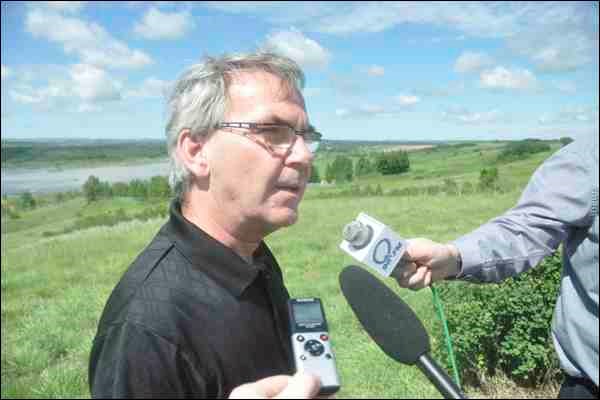The City of North Battleford shut down Water Treatment Plant No.1 Tuesday and has built a protective barrier in anticipation of a one-in-50-year flood on the North Saskatchewan River.
Crews worked overnight Tuesday to build the barrier around the plant. It is located right next to the North Saskatchewan River near the Battlefords Bridge.
While the North Saskatchewan spilled over into the nearby banks and fields Wednesday, the mayor of North Battleford expressed confidence that North Battleford was ready and that its water supply was protected.
"I'm very satisfied, to put it that way, in the sense that city administration and city crews have taken precautions to ensure the safety of the water supply in the city," said Mayor Ian Hamilton.
The City could have still opted to keep the plant running, but made the decision to close it as a precautionary measure, according to Deputy Fire Chief Brian Wilson.
"We don't expect river levels to cause any kind of compromise to that plant," said Wilson.
"However, in order to err on the side of caution we've engaged some help from the province and we've set up some temporary diking around the water treatment plant."
With the plant shut down, the City will be relying on F.E. Holliday Water Treatment Plant No.2 for water for what was expected to be a few days. Wilson said there should not be a major impact on the water supply.
"We have lots of water in the city. The water tower is full, the reservoirs are full, we have Water Treatment Plant No. 2 running," said Wilson.
Both Wilson and Hamilton said there is nothing affecting the water quality. However, there is an outdoor watering ban in effect, mainly to ensure there is sufficient water available in the event of emergencies such as fires.
The protective barrier is 720 feet long by approximately five to six feet tall. According to the city, approximately 600 tons of sand was used in its construction.
Crews from the City of North Battleford, from North Battleford fire department, the office of the Fire Commissioner and Ministry of Environment worked throughout Tuesday night and into Wednesday morning to construct the barrier. Local contractors G & C Asphalt and Unicon Pipeline were instrumental in providing equipment, hauling sand and filling sandbags, said the fire department.
The Ministry of Environment sent in their forestry firefighting teams to help.
Wilson said there were about 45 people from various agencies building the barrier. The mayor expressed his confidence the work done would protect the plant and allow it to get back in operation quickly once the river subsides.
The shutdown of Water Treatment Plant No. 1 was announced Tuesday evening after new reports came in that the flow on the North Saskatchewan River would be higher than expected.
Dan Maloney of the Public Works Department told council Monday that production was expected to continue at the plant, with heavier equipment being required to travel in and out. He said then the flows were estimated to be 2,500 cubic metres per second.
But by Tuesday, that forecast had changed for the worse. Wilson said the report by that morning was for the flow to reach 3,800 cubic metres per second.
City officials were kept informed on the ever-changing water situation throughout the day. "Certainly, we've had a lot of dialogue with the Water Security Agency in terms of where we expect the water level to get to," said Wilson Wednesday.
The decision to close the plant and build the protective barrier was made Tuesday around 4:30 p.m.
There were no real concerns about residential or commercial flooding as both communities are well above ground. In addition to Water Treatment Plant No. 1, the biggest concern was with Battlefords District Care Centre in Battleford.
Mayor Hamilton was at that facility Tuesday and told reporters there had been sandbagging done there.
" I know they have contingency plans for evacuation, if necessary," said Hamilton.
By Wednesday morning, flooding was evident all along the North Saskatchewan River with water in Battleford Flats, ditches and flood plains in the river basin by morning. The boat launch area had already been closed and residents had been urged to stay clear of the river.
It was not expected major arteries would be compromised, though some roads nearest to the river did see a risk of flooding as of Wednesday.
Hamilton also acknowledged that once the flooding is over the standing water will be breeding ground for mosquitoes. "No one likes mosquitoes," said Hamilton, who said initiatives would be taken to address that concern over the coming months.
It's the most water to come down the river since 1986.
Hamilton told reporters he remembers that flood and believes water flows this year will rival what was experienced that year, which saw "significant flooding of the flats areas as well." Officials noted that the events of 1986 gave them some idea of what to expect this year.
Both Hamilton and Wilson expressed appreciation for all the hard work and dedication put in by those who helped the city prepare for the floodwaters.
Still, the local situation was nothing like what was seen in southern Alberta with devastation and the loss of lives there, as Hamilton pointed out.
"There's nobody in danger. No lives are in danger," said Hamilton.




